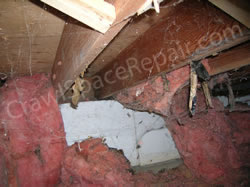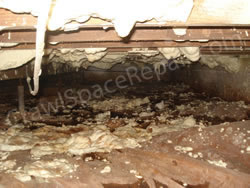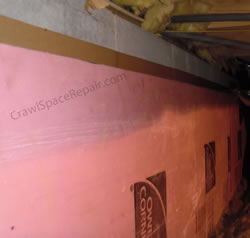Crawl Space Insulation Tips

The hot topic for the fall season is, what is the proper way to insulate a crawlspace? There are really two ways to get the most bang for your buck: one is adding insulation in the crawl space in the proper place, in the proper way and the other is to close the foundation vents that let in the outside air.
Let’s compare a crawl space to a basement for just a minute. Basements have windows, crawl spaces have foundation vents. Basements are under the home and so are crawl spaces. Most all basements have a vapor retarder under a concrete floor for comfort and moisture control and most all crawl spaces do not. Most all basements need some sort of dehumidification in order to control moisture and most all crawl spaces need some sort of dehumidification to control moisture. Because of the location in the home, basements are much cooler than the rest of the house and crawl spaces are also much coolr due to it’s location. Seems like these two spaces are very similar, just treated differently. So why do we treat them so differently?
What went wrong?

The fact is, crawl spaces hold far less value in a homes price tag. It is not considered living space and therefore it is not conditioned with the rest of the home. This simple difference is the beginning of what went wrong with crawl spaces. What if we transformed the crawl space using the same practices as a basement? Well let’s see, basement windows are closed so let’s just close the those foundation vents. Basements have moisture control in the floor system so we can install a vapor retarder on the floor of the crawl space. Basements most often need a dehumidifier so let’s add one to the crawl space. Basements are colder because of the location and no basement has insulation in the ceiling. In fact, it is code in almost every city and town in America to insulate the foundation walls of a basement prior to making it a conditioned space. What if we insulated a crawl space the same way?
Installing Crawl Space Insulation

Let’s talk about insulating the crawl space. The newest idea in crawl space insulation is to insulate between the inside and the outside of the home rather than insulating between the house in the crawl space. This follows all best practices of building envelope energy efficiency. By preventing the cold air from entering the homes envelope you can better protect your home from heat loss. Installing crawl space insulation on the foundation walls will get you the greatest result for the cost and effort, just like a basement.
With that being said, it's my recommendation that you use extruded rigid polystyrene insulation rather than spray foam polyurethane insulation. The biggest reason I recommend rigid foam over spray foam is because of the amount of moisture the insulation will absorb. Rigid foam absorbs far less moisture than spray foam does. This means, better results for a longer period of time. The Achilles’ heel of all insulation is moisture. This is why fiberglass insulation should not be used in a moist environment like an unconditioned crawl space.
Now, let’s talk about the other way to insulate your crawl space. Well maybe insulate isn’t the proper way to say it. It’s more of a preventative then it is a procedure. If you’re air-conditioning your home and you want to keep the cool air inside you wouldn’t open your windows for ventilation, you treat the air inside your home. The same is true in the opposite, if you’re heating your home you don’t open the windows and let the cold air in. When it comes to insulating a crawl space or preventing your crawl space from getting colder than you want, the most effective way, is to prevent the cold air from entering the crawl space. It is becoming well known that the crawl space foundation vents cause far more harm than they were ever meant to prevent. Closing the vents is simply not enough. The vents must be sealed in order to prevent the outside cold air from entering the crawl space. In fact, the number one thing you can do to lower your winter heating bills is to close the foundation vents.
Proper Crawl Space Insulation
Properly insulating a crawl space and properly handling the foundation vents is critical to saving hundreds of dollars a year in heating costs. Choosing the proper insulation will give you years of effective service and the best return on effort and cost. Correcting the problem with the foundation vents however, carries a much larger commitment. Your choices are: to seal your foundation vents before the winter every year and undo that work every spring OR you seal the entire crawl space permanently which will allow the foundation vents to remain closed all year. Then you can condition the crawl space and treated it as part of the house, just like a basement. It’s your house and you always have final say, but the facts are in and a conditioned crawl space is far more efficient than one that is not.